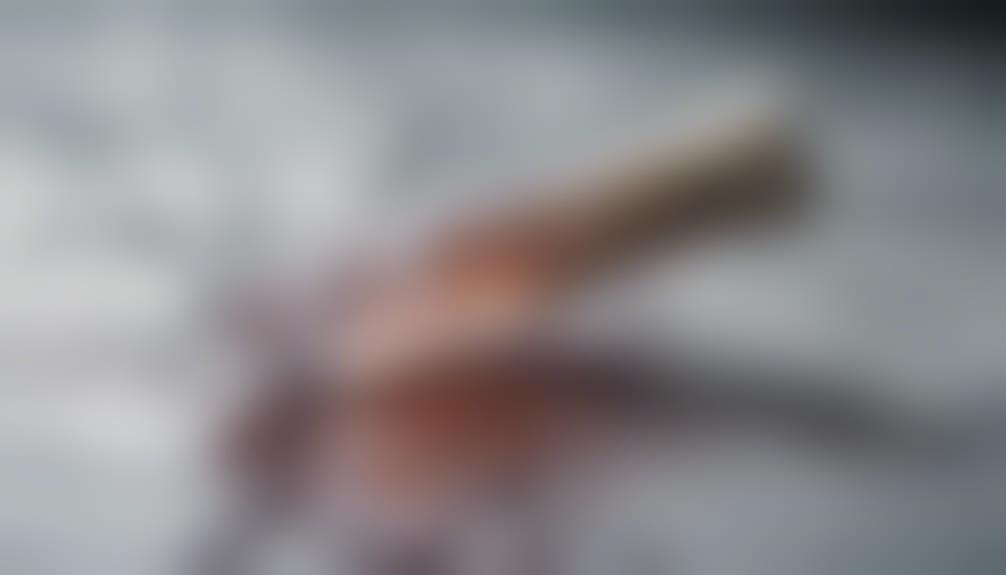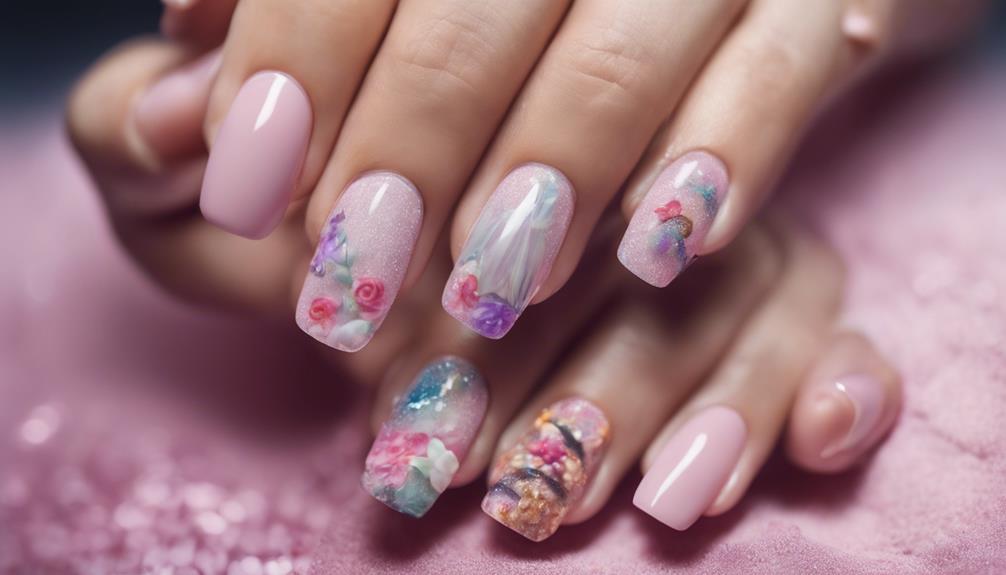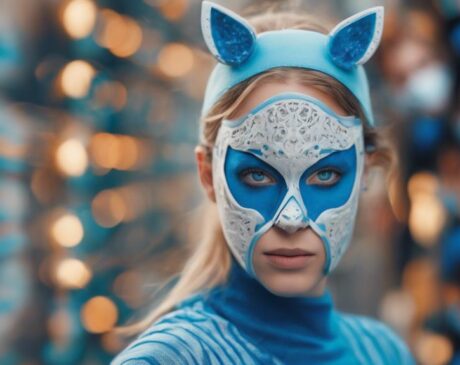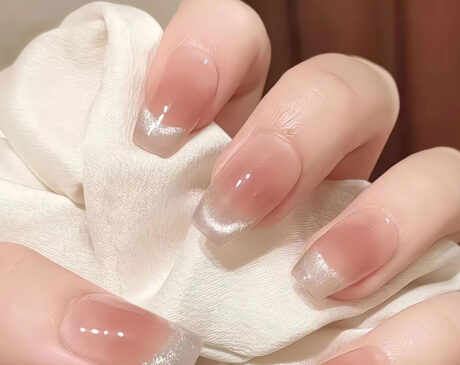Can You Use Acrylic Instead of Nail Glue?

When considering acrylic over nail glue, understand differences, benefits, drawbacks, and techniques for desired results. Acrylic offers strength, durability, and creativity for long-lasting manicures. However, watch for skin reactions, potential bond issues, and fume sensitivities. Proper application is key: clean, buff, layer, and blend acrylic evenly. Master techniques to enhance nail art with strength and customization. Troubleshoot bubble or lifting issues with precision and proper ratios. To remove, use specialized products and moisturize post-treatment. Prioritize safety with ventilation, protection, and airflow. Discover more about applying and removing acrylic for safe and stylish nails.
Key Takeaways
- Acrylic can be used as an alternative to nail glue.
- Consider differences in bonding properties.
- Ensure proper application techniques for success.
- Acrylic offers strength and durability for nails.
- Prioritize safety precautions when using acrylic.
Acrylic Vs Nail Glue: Understanding Differences

Frequently misunderstood, the distinctions between acrylic and nail glue are essential for achieving optimal results in nail applications. When comparing application techniques, acrylic offers more versatility than nail glue. Acrylic can be sculpted into various shapes and lengths, providing a customized look that nail glue may not achieve.
In terms of durability, acrylic nails tend to be more robust and long-lasting compared to nail glue applications. The cost comparison between acrylic and nail glue can vary depending on individual preferences and needs. While acrylic may have a higher upfront cost due to the need for additional tools and products, it can be more cost-effective in the long run due to its durability.
Moreover, the versatility of acrylic allows for creative nail designs and extensions that nail glue alone may not be able to support. Understanding these key differences is crucial for nail enthusiasts looking to elevate their nail game with innovative techniques and long-lasting results.
Pros of Using Acrylic for Nails
When considering nail enhancements, the utilization of acrylic presents numerous advantages that cater to durability and artistic flexibility in nail applications. In the realm of nail care, acrylic nails stand out for their strength and longevity compared to traditional nail glue. They offer a robust solution for individuals seeking long-lasting manicures that can withstand daily activities without chipping or breaking easily.
Moreover, acrylic nails provide a versatile canvas for creativity, allowing nail enthusiasts to experiment with various designs and styles. This aligns well with current DIY trends, where individuals are increasingly embracing at-home nail art projects. The ease of working with acrylic also makes it a popular choice for those looking to express themselves through intricate nail designs without the need for frequent touch-ups.
Cons of Using Acrylic Instead

When opting to use acrylic instead of nail glue, it is essential to consider potential cons.
Adverse reactions to acrylic products are possible, which can lead to skin irritation or allergies.
Additionally, the bond created by acrylic may not last as long as traditional nail glue, resulting in a need for more frequent maintenance.
Adverse Reactions Possible
Occasionally, individuals may experience adverse reactions when opting to use acrylic instead of nail glue for nail applications. These adverse reactions can range from mild irritation to more severe allergic responses. Acrylic contains chemicals that may not agree with everyone's skin, leading to redness, itching, or swelling around the nail area.
Moreover, some individuals may be sensitive to the fumes emitted during the acrylic application process, causing respiratory issues or skin discomfort. It is essential for individuals considering acrylic nail applications to be aware of these potential adverse reactions and to conduct a patch test before full application.
Prioritizing safety and understanding one's body's response to different products is crucial in ensuring a positive nail enhancement experience.
Bond May Not Last
The longevity of the bond between acrylic nails and the natural nail may be compromised when opting to use acrylic instead of nail glue for nail applications. While acrylic can offer strength and durability, the long-term durability of the bond may not be as reliable as when using specialized nail glue.
This compromise in bond longevity poses potential risks such as premature lifting or breakage of the acrylic nails. It is important to consider that the adhesive properties of acrylic alone may not provide the same level of adhesion as nail glue formulated specifically for nail applications.
Therefore, when looking for a lasting and secure bond between artificial and natural nails, opting for nail glue over acrylic may be the more prudent choice for maintaining nail integrity.
How to Apply Acrylic as Nail Adhesive
To effectively apply acrylic as a nail adhesive, ensure that the nail surface is clean and free of any oils or residue. Begin by gently buffing the nails to create a rough surface for better adhesion. Apply a thin layer of acrylic powder over the nail, followed by a small amount of acrylic liquid. Using a brush, gently blend the powder and liquid together until it forms a smooth paste. Working quickly, apply the acrylic mixture onto the nail, starting from the cuticle and moving towards the tip in a gentle, even motion. Allow the acrylic to dry completely before applying a second coat for added strength.
When considering nail adhesive alternatives, acrylic application offers a durable and long-lasting bond that can withstand daily activities. Unlike traditional nail glue, acrylic provides a strong hold that is less likely to break or chip. By following these steps for applying acrylic as a nail adhesive, you can enjoy beautiful, salon-quality nails in the comfort of your own home.
Tips for Using Acrylic With Nail Art

When incorporating acrylic with nail art, it is essential to consider the differences between acrylic and nail glue to achieve the desired results.
Proper application techniques can make a significant difference in the longevity and appearance of the nail art.
Understanding the nuances of working with acrylic can help elevate your nail art game and ensure a professional finish.
Acrylic Vs Nail Glue
For optimal results in nail art application, understanding the nuances between acrylic and nail glue is essential. Acrylic nails offer superior strength and durability compared to nail glue, making them ideal for long-lasting manicures.
While nail glue can provide a quick fix, acrylic nails are more cost-effective in the long run due to their longevity. Additionally, acrylic nails allow for endless creative possibilities, as they can be shaped and customized to achieve various aesthetic effects that are not easily achievable with nail glue alone.
Applying Acrylic Properly
Acrylic application in nail art requires meticulous attention to detail and precision for achieving flawless results. When applying acrylic properly, mastering various techniques and troubleshooting common issues is essential. Different types of acrylic powders and liquids offer unique characteristics that can affect the outcome of your nail art. Here is a table showcasing some key aspects to consider:
| Acrylic Application Techniques | Troubleshooting |
|---|---|
| Proper ratio of powder to liquid | Avoiding air bubbles |
| Creating smooth and even layers | Preventing lifting at the cuticle |
| Correct nail preparation | Handling product consistency issues |
Removing Acrylic Nail Adhesive
To effectively eliminate acrylic nail adhesive, it is essential to utilize specialized products designed for safe and efficient removal. Proper removal of acrylic nail adhesive is crucial to avoid damage to the natural nail bed and surrounding skin. One recommended method is to soak a cotton ball in acetone-based nail polish remover and place it directly on the nail. Secure the cotton ball with aluminum foil to enhance the absorption of the adhesive.
After allowing it to sit for about 15-20 minutes, gently rub the acrylic nail to remove any softened adhesive. It is important to be patient during this process to prevent any tearing or damage to the natural nail. If the adhesive is stubborn, repeat the soaking process until the acrylic nail can be easily removed.
Always remember to moisturize the nails and surrounding skin after removal to restore moisture and prevent dryness. By following these steps, you can effectively remove acrylic nail adhesive while maintaining the health and integrity of your nails.
Safety Precautions When Using Acrylic

When working with acrylic products for nail application, prioritizing safety measures is paramount to prevent any potential harm or damage to the nails and surrounding skin. Proper ventilation is crucial when using acrylic products to minimize exposure to harmful fumes. Ensuring adequate airflow in your workspace can help dissipate acrylic fumes, promoting a healthier environment.
Additionally, wearing skin protection such as gloves is essential to prevent direct contact between the acrylic substances and your skin, reducing the risk of irritation or allergic reactions.
Eye protection is another critical aspect to consider when working with acrylic products. Shielding your eyes with safety goggles can prevent accidental splashes or fumes from coming into contact with your eyes, safeguarding your vision.
Frequently Asked Questions
Can Acrylic Be Used as a Substitute for Nail Glue in All Types of Nail Applications?
When comparing acrylic vs. nail glue, it's crucial to consider the specific nail application. While acrylic can serve as a substitute in some instances, it's essential to weigh the pros and cons for optimal results and durability.
Is There a Specific Type of Acrylic That Works Best as a Nail Adhesive?
When seeking the best acrylic alternatives for nail adhesion, considering formulations designed for nail health is crucial. Opt for products that prioritize nail health, ensuring a balance between durability and gentle application for optimal results.
Are There Any Long-Term Effects on the Nails From Using Acrylic as a Nail Adhesive?
In the realm of nail health, using acrylic as an adhesive may present long-term effects. Improper application of acrylic can lead to weakened nails, breakage, and potential damage. It is crucial to prioritize proper techniques and seek professional guidance.
Can Acrylic Be Used to Fix Broken Nails or Only as an Adhesive for Applying Artificial Nails?
When it comes to nail repair and DIY tips, acrylic can be used effectively for fixing broken nails. It is a versatile option compared to gel and can be a handy solution for those seeking innovative nail repair techniques.
Are There Any Specific Brands or Products That Are Recommended for Using Acrylic as a Nail Adhesive?
When looking for the best brands for using acrylic as a nail adhesive, consider reputable names like Mia Secret and Young Nails. Application tips include using a small amount, working quickly, and ensuring thorough coverage for strong adhesion.
Conclusion
In conclusion, while acrylic can be used as an alternative to nail glue, it may not provide the same level of adhesion and longevity. It is important to consider the pros and cons before using acrylic for nail application. Remember to follow proper application techniques and safety precautions when using acrylic as a nail adhesive.
One interesting statistic to note is that the global nail care market is expected to reach $11.6 billion by 2024, showing the widespread popularity of nail products.




